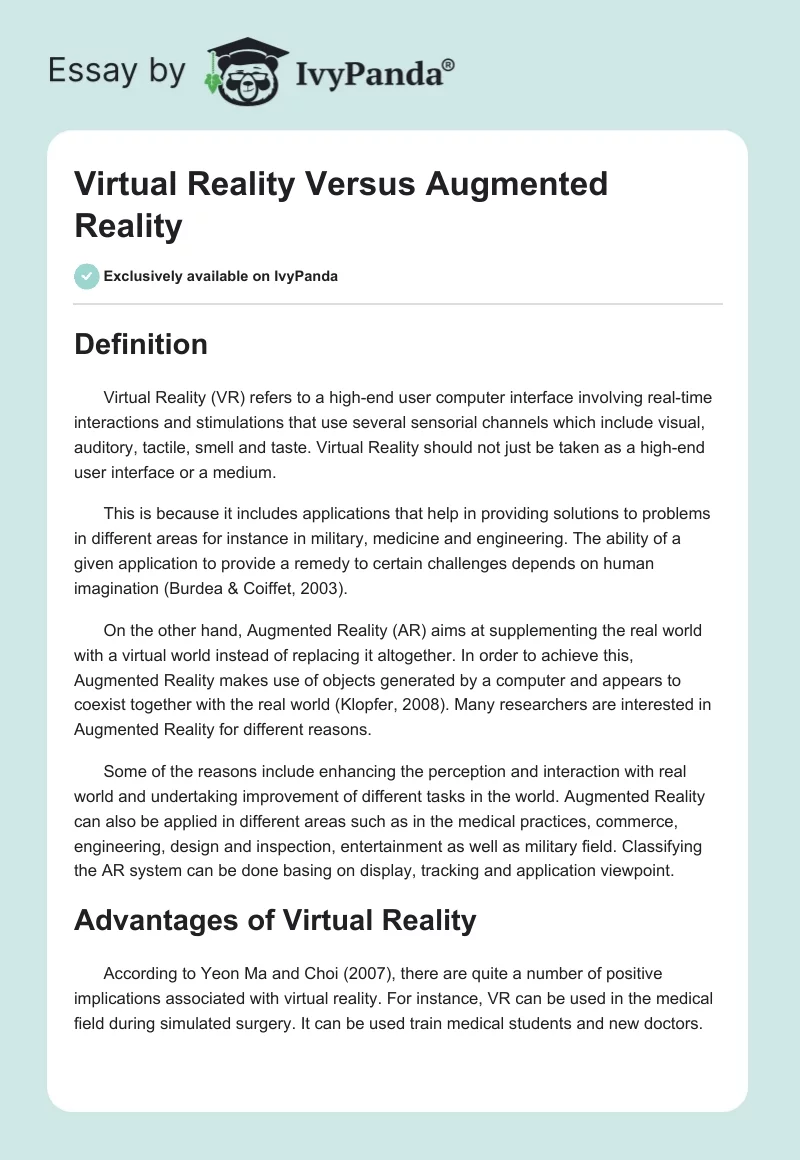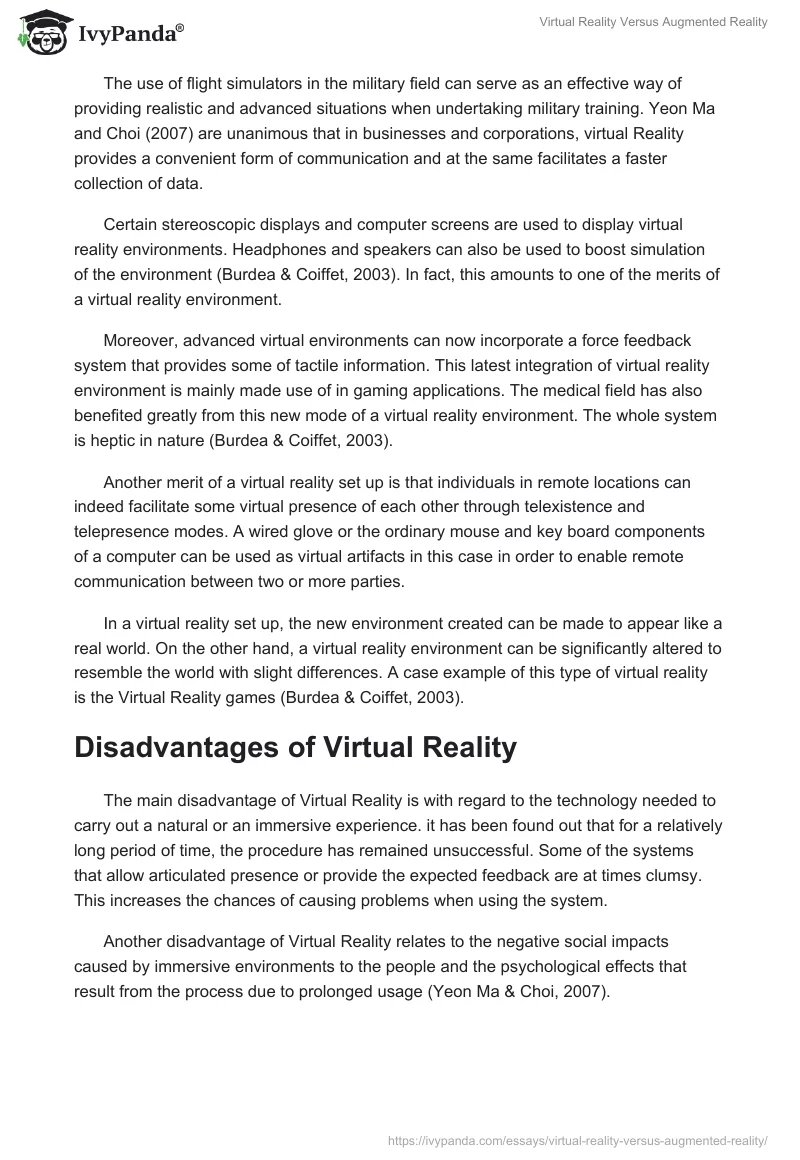Definition
Virtual Reality (VR) refers to a high-end user computer interface involving real-time interactions and stimulations that use several sensorial channels which include visual, auditory, tactile, smell and taste. Virtual Reality should not just be taken as a high-end user interface or a medium.
This is because it includes applications that help in providing solutions to problems in different areas for instance in military, medicine and engineering. The ability of a given application to provide a remedy to certain challenges depends on human imagination (Burdea & Coiffet, 2003).
On the other hand, Augmented Reality (AR) aims at supplementing the real world with a virtual world instead of replacing it altogether. In order to achieve this, Augmented Reality makes use of objects generated by a computer and appears to coexist together with the real world (Klopfer, 2008). Many researchers are interested in Augmented Reality for different reasons.
Some of the reasons include enhancing the perception and interaction with real world and undertaking improvement of different tasks in the world. Augmented Reality can also be applied in different areas such as in the medical practices, commerce, engineering, design and inspection, entertainment as well as military field. Classifying the AR system can be done basing on display, tracking and application viewpoint.
Advantages of Virtual Reality
According to Yeon Ma and Choi (2007), there are quite a number of positive implications associated with virtual reality. For instance, VR can be used in the medical field during simulated surgery. It can be used train medical students and new doctors.
The use of flight simulators in the military field can serve as an effective way of providing realistic and advanced situations when undertaking military training. Yeon Ma and Choi (2007) are unanimous that in businesses and corporations, virtual Reality provides a convenient form of communication and at the same facilitates a faster collection of data.
Certain stereoscopic displays and computer screens are used to display virtual reality environments. Headphones and speakers can also be used to boost simulation of the environment (Burdea & Coiffet, 2003). In fact, this amounts to one of the merits of a virtual reality environment.
Moreover, advanced virtual environments can now incorporate a force feedback system that provides some of tactile information. This latest integration of virtual reality environment is mainly made use of in gaming applications. The medical field has also benefited greatly from this new mode of a virtual reality environment. The whole system is heptic in nature (Burdea & Coiffet, 2003).
Another merit of a virtual reality set up is that individuals in remote locations can indeed facilitate some virtual presence of each other through telexistence and telepresence modes. A wired glove or the ordinary mouse and key board components of a computer can be used as virtual artifacts in this case in order to enable remote communication between two or more parties.
In a virtual reality set up, the new environment created can be made to appear like a real world. On the other hand, a virtual reality environment can be significantly altered to resemble the world with slight differences. A case example of this type of virtual reality is the Virtual Reality games (Burdea & Coiffet, 2003).
Disadvantages of Virtual Reality
The main disadvantage of Virtual Reality is with regard to the technology needed to carry out a natural or an immersive experience. it has been found out that for a relatively long period of time, the procedure has remained unsuccessful. Some of the systems that allow articulated presence or provide the expected feedback are at times clumsy. This increases the chances of causing problems when using the system.
Another disadvantage of Virtual Reality relates to the negative social impacts caused by immersive environments to the people and the psychological effects that result from the process due to prolonged usage (Yeon Ma & Choi, 2007).
In terms of demerits, it has proved to be cumbersome to develop a virtual reality environment with high-fidelity. Some of the factors that limit this possibility include communication bandwidth, image resolution, and processing power.
Comparison between Virtual Reality and Augmented Reality
Differences between Virtual Reality and Augmented Reality are based on the level of immersion of the system. A major difference between the two is that a Virtual Reality system aims at reaching a fully immersive virtual environment and uses factors generated by a computer.
This is the environment where the user performs his or her task. On the other hand, an Augmented Reality aims at combining both the virtual and real world. This is mainly aimed at assisting a given user to perform a task from a physical setting (Johnson & Sasse, 1999).
Another difference between the two is that Virtual Reality usually limits the physical movement of the user, whereas Augmented Reality requires the system to be portable especially when dealing with the outdoor augmented reality systems.
However, it is pertinent to note that Virtual Reality and Augmented Reality share some common features. For example, they both share three dimensional images and interactivity and can be applied in similar fields (Yeon Ma & Choi, 2007).
References
Burdea, G., & Coiffet, P. (2003). Virtual Reality technology. Hoboken, N.J: J. Wiley Interscience.
Johnson, C., Sasse, M. A. (1999). International Conference on Human-Computer Interaction & Interact: Human-computer interaction. Amsterdam: IOS Press.
Klopfer, E. (2008). Augmented Learning: Research and Design of Mobile Educational Games.New York: MIT Press.
Yeon Ma, J. & Choi, J.S.(2007). The Virtuality and Reality of Augmented Reality. London: Academy Publisher.


